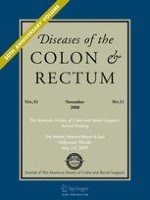Erschienen in:

01.11.2008 | Original Contribution
Outcomes of Stapled Transanal Rectal Resection vs. Biofeedback for the Treatment of Outlet Obstruction Associated with Rectal Intussusception and Rectocele: A Multicenter, Randomized, Controlled Trial
verfasst von:
Paul A. Lehur, M.D., Angelo Stuto, M.D., Michel Fantoli, M.D., Roberto D. Villani, M.D., Michel Queralto, M.D., Franck Lazorthes, M.D., Michael Hershman, M.D., Alfonso Carriero, M.D., François Pigot, M.D., Guillaume Meurette, M.D., Prashanty Narisetty, M.D., Richard Villet, M.D., for the ODS II Study Group
Erschienen in:
Diseases of the Colon & Rectum
|
Ausgabe 11/2008
Einloggen, um Zugang zu erhalten
Abstract
Purpose
This study was designed to assess the safety and outcomes achieved with stapled transanal rectal resection vs. biofeedback training in obstructed defecation patients.
Methods
A total of 119 women patients who suffered from obstructed defecation with associated rectocele and rectal intussusception were randomized to stapled transanal rectal resection or biofeedback training. Stapled transanal rectal resection was performed by using two circular staplers to produce transanal full-thickness rectal resection. Primary outcome was symptoms of obstructed defecation resolution at 12 months; secondary outcomes included safety, change in quality of life score, and anatomic correction of rectocele and rectal intussusception.
Results
Fourteen percent (8/59) stapled transanal rectal resection and 50 percent (30/60) biofeedback training patients withdrew early. Eight (15 percent) patients treated with stapled transanal rectal resection and 1 (2 percent) biofeedback patient experienced adverse events. One serious adverse event (bleeding) occurred after stapled transanal rectal resection. Scores of obstructed defecation improved significantly in both groups as did quality of life (both P < 0.0001). Successful treatment was observed in 44 (81.5 percent) stapled transanal rectal resection vs. 13 (33.3 percent) evaluable biofeedback training patients (P < 0.0001). Functional benefit was observed early and remained stable during the study.
Conclusions
In this controlled trial, stapled transanal rectal resection was well tolerated, was more effective than biofeedback training for the resolution of obstructed defecation symptoms, and improved quality of life, with minimal risk of impaired continence. Thus, stapled transanal rectal resection offers a new treatment alternative for obstructed defecation after failure of conservative measures including biofeedback training, a noninvasive approach.











